How to Control 120V/240V Motor using Multifunction ON-OFF Delay Timer?
In today’s step-by-step wiring tutorial, we will learn how to wire an OFF-delay and ON-delay timer for 120V and 240V AC motors. The same multipurpose digital timer can be used for both AC and DC (12V-240V) load applications based on the circuit design and requirements.
A multifunction timer relay (such as CRM-91H, CRM93H, CRM-82, CRM9S, etc., by Elko, Migro, Geya, and other brands) can be used for various applications, including On-delay, OFF-delay, one-shot, repeat cycle, memory latching, interval-ON, flashing OFF, etc.
As we are going to wire the circuit for ON and OFF Delay operations, it’s essential to understand the difference between ON Delay and OFF delay timer.
ON Delay: As the name suggests, it delays the switching ON operation of the circuit. In other words, when the timer is activated, its Common will not connect from NC to the NO at once (where the load is connected to the NC terminal) until the predefined time period expires. After that, the load will be ON, providing a delay in operation after the preset time expires.
OFF Delay: As indicated by the name, it delays the turning-off operation for the connected load. Alternatively, when the timer is activated, its Common will not connect from NC to the NO immediately (where the load point is connected to the NO terminal) until the predefined time period expires. After that, the load will turn off, providing a delay in operation after the preset time expires.
Related Post:
- How to wire Twin Timer for 120V/240V Circuits – ON/OFF Delay
- How to Wire Twin Timer with Photo Eye Circuit for Time Delay?
ON Delay Timer in 120V/240V Circuits
Suppose we have two motors where we need to control one motor (directly connected to the 120V/240V power supply) using a timer or ON/OFF switch, while the second motor should turn on (with a proper delay) after the first one.
This setup can be useful to reduce the initial high starting current while operating two motors at the same time. Hence, the sequential operation of motors will not pull all the amperes to the circuit at once.
In an another scenario, the first motor feeds water to the second motor; hence, the second motor should not start until water is supplied by the first one. In this case, we provide an ON-delay mechanism to the 2nd motor’s circuit.
A 10 Amp fuse is added to the line (hot) to the timer to protect it from the high amperage running in the overall circuit.
As shown in the figure above, one motor is directly connected to the power supply, while the second one is connected via a timer and contactor. Use contactors or relays for both motors if the load current exceeds the rated capacity of the timer.
For ON-Delay operation, connect the A1 terminal of the contactor to the 18 – NO (Normally Open) terminal of the timer, as shown in the wiring diagram.
Related Posts:
- How to Toggle between Two Heat Pumps using 240V Twin Timer?
- How to Toggle Electric Water Heater Between 120V and 240V?
OFF Delay Timer in 120V/240V Circuits
The purpose of this circuit is opposite compared to the above one; it will delay the turning-off operation of the circuit for a specified time period.
If you observe, the circuit for OFF-delay operation is the same as above for the ON-delay operation using the same delay timer (CRM-91H), except the A1 terminal of the contactor is connected to the 16 – NC (Normally Closed) terminal of the timer.
This setup is useful when we need to control the ON/OFF operation of the first motor first and then the second one in sequence.
Related Posts:
- How to Control 120V & 240V Water Heater using ST01 Timer and Contactors?
- How to Wire ST01 Timer with Relay & Contactor for 120V/240V Motors?
ON/OFF Delay in a Single Cricut
f you require both ON-delay and OFF-delay mechanisms in a single circuit for 120V or 240V, the CRM-93H (or any other similar) multifunction delay timer provides the solution.
As shown in the wiring diagram:
- A light bulb in the hallway is directly connected to the 120/240V supply and controlled by a timer or ON/OFF switch.
- The motor is connected to the 16-NC (Normally Closed) terminal of the contactor.
- The Green indicator bulb is connected to the 28-NO (Normally Open) terminal of the contactor.
- The Red indicator bulb is connected to the 36-NC (Normally Closed) terminal of the contactor.
Working of the Circuit:
- The ON/OFF operation of the light bulb in the hallway can be automatically or manually controlled using a timer or a 2-way switch, respectively.
- When the motor turns on after an OFF-delay, the Red indicator will also turn on, showing the motor is running. Both the Motor and Red indicator are connected to the NC terminals of the delay timer.
- When the motor turns off after the predefined time period expires, the green indicator will turn on, showing the motor is switched off. The green indicator is connected to the NO terminal of the delay timer.
In this circuit, the red indicator light and motor are controlled using a delay timer with OFF-delay mechanism, while the green indicator light is controlled by ON-delay mechanism.
- Use relays and contactors for high-amperage load applications such as water heaters and motors, etc.
- Use black for hot and white for neutral in 120V AC circuits.
- Use black for Hot 1 (Line 1) and red for Hot 2 (Line 2) in 240V AC circuits.
- Connect the bare conductor or green wire for protected ground to each applicable appliance according to the local area codes.
Related Posts:
- How to Reduce Runtime of Air-Conditioner During Peak Hours?
- How to Wire One-Shot Timer using Twin Timer For Delay?
- How to Wire ON-Delay Timer for 120V and 240V Load Circuits?
- How to Wire OFF-Delay Timer for 120V and 240V Load Circuits?
- Difference Between ON Delay and OFF Delay Timer
- How to Wire ON/OFF Delay Timer for AC & DC Loads – 230V & 24VDC
- Automatic & Manual Control of 3-Phase Motor Using Delay Timer
- Automatic ON/OFF Circuit Using Two 8-PIN Timers for 1 & 3-Φ Load
- How to Wire AH3 OFF-Delay Timer and Relay with Boiler Fan?
- How to Reverse Operation of Photo Eye for Motor using Relay?
- How to Reverse Operation of Photo Eye using ST01 Timer?
- How to Wire ST01 Timer for Dusk-Dawn On-Delay Light Control?
- How to Wire Spring Wound Timer with LYS Rely for ON/OFF Delay
- How to Wire Remote Control Countdown Timer?




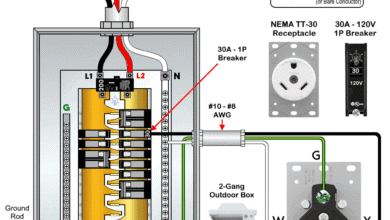 How to Wire NEMA TT-30 Receptacle for RVs & Travel Trailers
How to Wire NEMA TT-30 Receptacle for RVs & Travel Trailers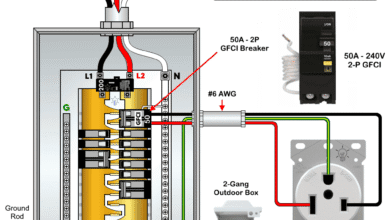 How to Wire a 50A – 250V, NEMA 6-50 Receptacle
How to Wire a 50A – 250V, NEMA 6-50 Receptacle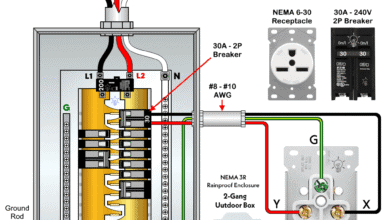 How to Wire a 30A – 250V, NEMA 6-30 Receptacle
How to Wire a 30A – 250V, NEMA 6-30 Receptacle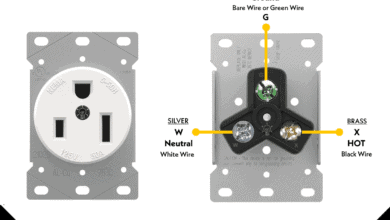 How to Wire a 50A – 125V – NEMA 5-50 Receptacle
How to Wire a 50A – 125V – NEMA 5-50 Receptacle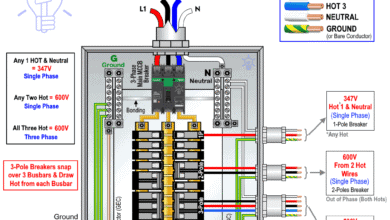 How to Wire 600/347V, 1-Phase & 3-Phase Main Service Panel
How to Wire 600/347V, 1-Phase & 3-Phase Main Service Panel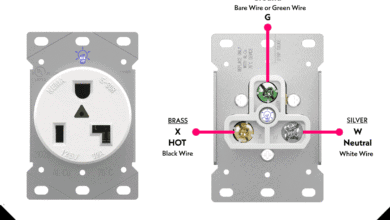 How to Wire a 30A – 125V – NEMA 5-30 Receptacle
How to Wire a 30A – 125V – NEMA 5-30 Receptacle